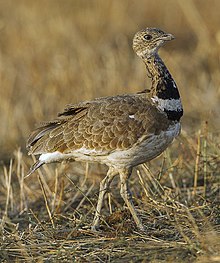Little bustard
| Little bustard | |
|---|---|

| |
| Male | |

| |
| Female | |
| Scientific classification | |
| Domain: | Eukaryota |
| Kingdom: | Animalia |
| Phylum: | Chordata |
| Class: | Aves |
| Order: | Otidiformes |
| Family: | Otididae |
| Genus: | Tetrax T. Forster, 1817 |
| Species: | T. tetrax
|
| Binomial name | |
| Tetrax tetrax | |

| |
| Range of T. tetrax Breeding Resident Non-breeding Passage Probably extinct Extinct
| |
| Synonyms | |
|
Otis tetrax Linnaeus, 1758 | |
The little bustard (Tetrax tetrax) is a bird in the bustard family, the only member of the genus Tetrax. The genus name is from Ancient Greek and refers to a gamebird mentioned by Aristophanes and others.[3]
Distribution
[edit]It breeds in Southern Europe and in Western and Central Asia. Southernmost European birds are mainly resident, but other populations migrate further south in winter. The central European population once breeding in the grassland of Hungary became extinct several decades ago. The species is declining due to habitat loss throughout its range. It used to breed more widely, for example ranging north to Poland occasionally.[4] It is only a very rare vagrant to Great Britain despite breeding in France. On 20 December 2013, the Cypriot newspapers 'Fileleftheros' and 'Politis', as well as news website 'SigmaLive', reported the discovery of a dead little bustard in the United Nations Buffer Zone. The bird had been shot by poachers hunting illegally in the zone. The shooting was particularly controversial amongst conservationists and birders since the little bustard is a very rare visitor to Cyprus and had not been officially recorded in Cyprus since December 1979.[5]
Description
[edit]Although the smallest Palearctic bustard, the little bustard is still pheasant-sized at 42–45 cm (17–18 in) long with a 90–110 cm (35–43 in) wingspan and a weight of 830 g (29 oz).[6] In flight, the long wings are extensively white. The breeding male is brown above and white below, with a grey head and a black neck bordered above and below by white.

The female and non-breeding male lack the dramatic neck pattern, and the female is marked darker below than the male. Immature bustards resemble females. Both sexes are usually silent, although the male has a distinctive "raspberry-blowing" call: prrt.
Diet
[edit]This species is omnivorous, taking seeds, insects, rodents and reptiles.
Breeding
[edit]Like other bustards, the male little bustard has a flamboyant display with foot stamping and leaping in the air. Females lay 3 to 5 eggs on the ground.
Habitat
[edit]The bird's habitat is open grassland and undisturbed cultivation, with plants tall enough for cover. Males and females do not differ markedly in habitat selection.[7] It has a stately slow walk, and tends to run when disturbed rather than fly. It is gregarious, especially in winter.
Tracking of male Little Bustards has revealed that they are nocturnal migrants that make frequent stopovers in non-irrigated and irrigated croplands to reach more productive agricultural post-breeding areas. [8]
References
[edit]- ^ BirdLife International (2018). "Tetrax tetrax". IUCN Red List of Threatened Species. 2018: e.T22691896A129913710. doi:10.2305/IUCN.UK.2018-2.RLTS.T22691896A129913710.en. Retrieved 11 November 2021.
- ^ "Appendices | CITES". cites.org. Retrieved 14 January 2022.
- ^ Jobling, James A (2010). The Helm Dictionary of Scientific Bird Names. London: Christopher Helm. p. 383. ISBN 978-1-4081-2501-4.
- ^ Tomek, Teresa; Bocheński, Zygmunt (2005). "Weichselian and Holocene bird remains from Komarowa Cave, Central Poland". Acta Zoologica Cracoviensia. 48A (1–2): 43–65. doi:10.3409/173491505783995743.
- ^ "Little Bustard Shot". cyprusbirdingtours.com. 17 December 2013. Retrieved 15 March 2014.
- ^ "BTO BirdFacts: Little Bustard". British Trust for Ornithology. Retrieved 13 January 2018.
- ^ Devoucoux, Pierrick; Besnard, Aurélien; Bretagnolle, Vincent (2019). "Sex-dependent habitat selection in a high-density Little Bustard Tetrax tetrax population in southern France, and the implications for conservation". Ibis. 161 (2): 310–324. doi:10.1111/ibi.12606. ISSN 1474-919X. S2CID 54035952.
- ^ Alonso, H.; Correia, R.A.; Marques, A.T.; Palmeirim, J.M.; Moreira, F.; Silva, J.P. (2020). "Male post‐breeding movements and stopover habitat selection of an endangered short‐distance migrant, the Little Bustard Tetrax tetrax". Ibis. 162 (2): 279–292. doi:10.1111/ibi.12706. hdl:10451/46413.
External links
[edit]- Oiseaux.net Little bustard photos
- "Little bustard media". Internet Bird Collection.
- Little bustard photo gallery at VIREO (Drexel University)
- Interactive range map of Tetrax tetrax at IUCN Red List maps
- BirdLife species factsheet for Tetrax tetrax
- "Tetrax tetrax". Avibase.
- Audio recordings of Little bustard on Xeno-canto.



